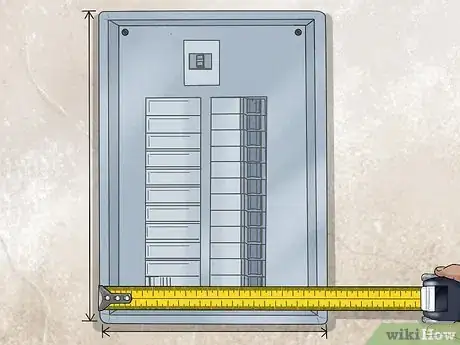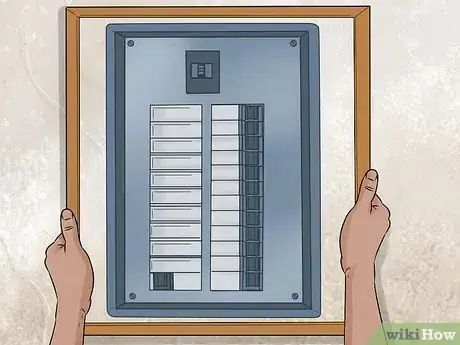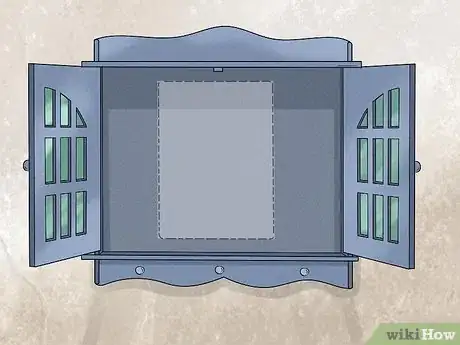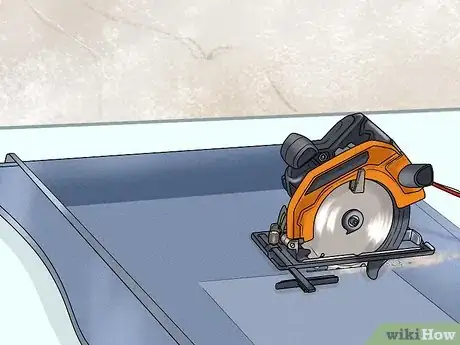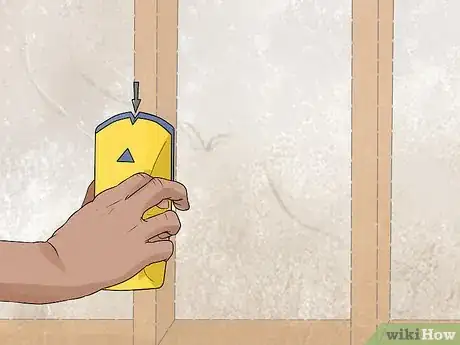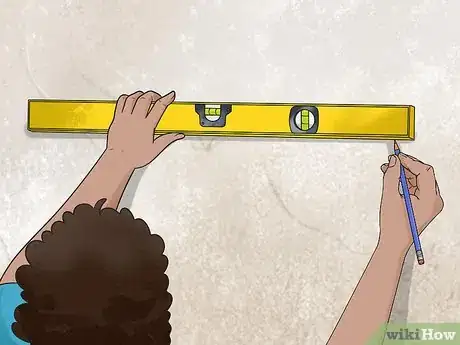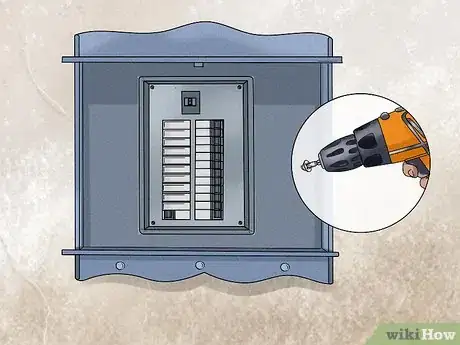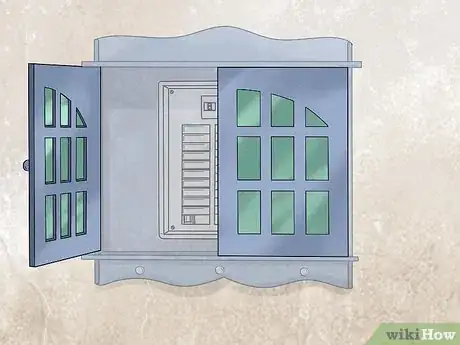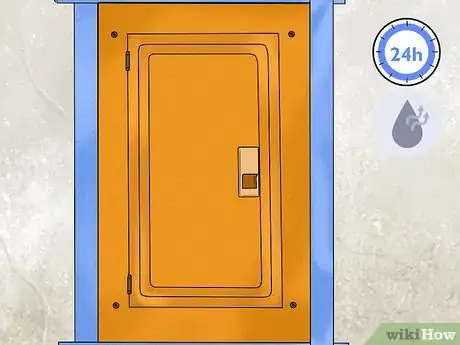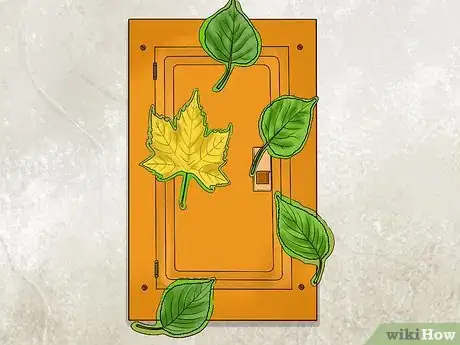This article was co-authored by Marvin Woo. Marvin Woo is a licensed electrician and the Owner of Woo's Electrical & Appliance based in East O’ahu. With over two decades of experience, he specializes in troubleshooting issues and maintaining residential electrical systems. Marvin is both licensed and insured to complete electrical work in the state of Hawaii.
There are 9 references cited in this article, which can be found at the bottom of the page.
This article has been viewed 97,558 times.
Circuit breaker boxes are often unpleasant to look at and costly to move. Fortunately, you can decorate over the box to blend it in with the rest of the room. For a quick fix, try hanging a painting or covered frame over it. A circuit breaker can also be hidden inside a cabinet as long as you keep it accessible. If you like painting, try using spray paint to blend the box in with the rest of the room. With a little creativity, you can make any room more appealing by hiding the circuit breaker.
Steps
Covering It with a Frame
-
1Check with building codes first. Depending on where you live, you may not be allowed to cover your breaker box in the manner suggested below.[1]
- If a renter, be sure to consult with the landlord about any plans, especially any involving covering up a breaker box. It may not only break code, but also make it difficult to get to a breaker box in an emergency situation.
- If a homeowner, be aware that even if alterations do not break code, doing so means that in an emergency firefighters, electricians, or even neighbors may not be able to find the breaker box.
- If you can cover the breaker box, be aware it may be wise to clearly label where it is anyway. In an emergency, it may need quick access.
-
2Measure the circuit breaker perimeter. Use a tape measure to measure all the way around the outside edge of the box. Write down both the box's length and width so you can get a frame that fits over it.
- If your circuit breaker sticks out from the wall, measure its depth as well.
- There needs to be at least 3 in (7.6 cm) of working space around the breaker panels at all times.[2]
Advertisement -
3Buy a painting or frame that is bigger than the box. If you can find a piece of art you like, it makes for a great cover. Otherwise, you can buy frames from craft or hobby stores. You can also construct your own frame if you can’t find one to buy.
- Some frames, like shadow boxes, can be opened. Make sure you have enough space on the wall for the frame to open completely.
- Choose a frame that is slightly bigger than the box so it can fit over it.
- The frame can be much bigger than the box. Bigger frames will take up extra wall space, so make sure this is what you want.
-
4Staple fabric to fit over the frame if it is exposed. If you need to cover an empty frame, pick up a piece of fabric from a craft supply store. Center the frame in the fabric, then fold the edges over the frame. Approximately every 1 in (2.5 cm) along the frame, staple the fabric to the wood.[3]
- If you have a hard time folding the fabric, try ironing it flat first. You can cut off any excess after you fold it.
- You can repurpose old blankets or other material to use as a frame cover.
-
5Hammer a nail into the wall to hang the frame. Place the nail above the box, at least 1 in (2.5 cm) above the center of the uppermost edge. Use a nail about 2 in (5.1 cm) long. Make sure the nail sticks out enough to hang the frame over the circuit breaker.
- The circuit breaker is always next to wooden support beams in the wall that can be used to support the frame.
- Just make sure you don't forget the circuit breaker box is there after you hang the frame up![4]
-
6Screw on the hinge if your frame opens. Find a recessed spot on the right or left side of the frame. If it isn’t there, use a chisel to chip out a spot as big as the hinge. Place the hinge, then use a 3 in (7.6 cm) steel screw to fasten it to the door. Secure the hinge’s other end to the frame’s base.[5]
- Make sure the door is tight against the frame before you screw the hinge in place.
Covering the Box with a Cabinet
-
1Measure the circuit breaker box’s size. Go around the box with a tape measure. Note the box’s length and width and keep these on hand as you look for an appropriate cabinet.
- Also measure the box's depth if your circuit breaker sticks out from the wall.
-
2Purchase a cabinet bigger than the circuit box. The cabinet has to fit around the box, allowing you easy access in case you need to reach inside. Leave at least 1 in (2.5 cm) between the breaker and the cabinet’s outer edge, if possible. This way, you have a little space to work with when screwing the cabinet to the wall.
- Your cabinet also needs to have a cuttable back end so you can create an opening for the box.
-
3Trace the box’s measurements on the cabinet’s back. Use the measurements you took earlier to sketch the box’s outline on the back of the cabinet. You can do this with a pencil and a ruler. Make sure the lines are straight and accurate so you can remove enough of the backing.[6]
-
4Cut out the back of the cabinet with a circular saw. Lay the cabinet flat. Cut slowly around the lines you sketched earlier. Once the back is off, hold the cabinet up to the box. If the box is obstructed, cut off more backing as needed before hanging the cabinet.[7]
- To protect yourself, wear form-fitting clothing. Put on safety goggles and headphones. A respirator mask is also useful.
-
5
-
6Trace hanging guidelines on the wall. Measure the cabinet with a tape measure, then sketch out its positioning on the wall. Using a straightedge, draw a line where the top edge of the cabinet will hang. Pay attention to the cabinet’s width so you know which parts hang over the wall studs.[9]
- The uppermost line is the most important measurement. This is the only one you need to draw unless you want to sketch the cabinet’s entire outline.
-
7Hang the cabinets with screws. Line up the top part of the cabinet with the line you sketched. Level the cabinet, using the line as a guide. Then, screw 2 1⁄2 in (6.4 cm) deck screws through the cabinet and its top and bottom mounting rails. These screws need to pass into the wall studs.[10]
- Leave about 3⁄4 in (1.9 cm) between the screws and the cabinet’s edges.
- You can check for levelness by holding a carpenter’s level over the cabinet. If the level is flat from side to side, the cabinet is level on the wall.
-
8Attach the cabinet’s hinges and door. Follow the instructions included with your cabinet to finish assembling it. Screw the hinges to the door along either the cabinet’s right or left edge, depending on how you want it to open. Then, hang the door to complete the installation.
Painting the Circuit Breaker Box
-
1Sand the circuit breaker box door with 120-grit sandpaper. Pick up a piece of fine-grit sandpaper from a home improvement store. Very lightly, rub the sandpaper all over the door. This should make the surface look dull and scratched, preparing it to hold paint.[11]
- To remove stubborn debris, scrub the door with a damp rag.
- Wipe the door with a clean cloth when you’re finished to remove any moisture and debris.
-
2Tape around the circuit breaker box. Spread a layer of painter’s tape over the wall. Press it down to ensure that it sticks in place. You may also want to move any furniture out of the area to avoid a painting mishap.[12]
- Ventilate the area by opening nearby doors and windows. Wear gloves, a respirator, and protective goggles.
- You probably will not need to protect the floor, but if you want to be safe, spread a drop cloth or newspaper underneath the box.
-
3Spray primer over the door. Get a can of primer at a paint supply store. Shake the can for a few seconds, then spray over the door. Work from side to side, moving the can slowly in order to coat the door in an even layer of primer.[13]
- Before you buy primer, read the label and make sure it is compatible with metal surfaces.
-
4Wait 24 hours for the primer to dry. Most primer begins drying after about 30 minutes. To stay safe, wait a whole day for it to dry and settle. This ensures the paint sticks without cracking.[14]
-
5Paint over the door. First, choose a spray paint that is labeled for use on metal surfaces. Use a color of spray paint that matches with the rest of your wall. Shake the can for a minute, then spray the paint over the primed surface. Work slowly, spraying from side to side across the box.[15]
- To get an even coat of paint, avoid rushing.
-
6Add another coat of paint to cover the box. After about 5 minutes, the first layer of spray paint will have settled. Go over the circuit breaker box again. Spray on a second light coating of paint using the same technique as before.
- You may need to repeat this step a couple of times before the paint looks nice and even.
-
7Wait 24 hours for the paint to dry. Once your circuit breaker box looks good, set the spray paint aside. The paint will soon begin drying, but to be safe, leave it alone for a whole day.[16]
-
8Decorate the box with magnets or other supplies. After the paint dries, your circuit breaker box should blend in pretty well with the rest of the wall. For additional decoration, try making and arranging your own magnets.
Expert Q&A
-
QuestionCan you hang a picture over a breaker box?
 Marvin WooMarvin Woo is a licensed electrician and the Owner of Woo's Electrical & Appliance based in East O’ahu. With over two decades of experience, he specializes in troubleshooting issues and maintaining residential electrical systems. Marvin is both licensed and insured to complete electrical work in the state of Hawaii.
Marvin WooMarvin Woo is a licensed electrician and the Owner of Woo's Electrical & Appliance based in East O’ahu. With over two decades of experience, he specializes in troubleshooting issues and maintaining residential electrical systems. Marvin is both licensed and insured to complete electrical work in the state of Hawaii.
Licensed Electrician You can as long as the breaker box is still readily accessible! Something temporary like a picture or calendar would be fine—just don't build anything permanent around it that will limit panel cover removal or quick access to the breakers.
You can as long as the breaker box is still readily accessible! Something temporary like a picture or calendar would be fine—just don't build anything permanent around it that will limit panel cover removal or quick access to the breakers.
Things You’ll Need
Covering It with a Frame
- Measuring tape
- Frame or frame boards
- Nail
- Fabric for uncovered frames
- Staple gun
Covering the Box with a Cabinet
- Measuring tape
- Pencil
- Cabinet
- Saw
- Stud-finder
- Screws
- Safety goggles
- Hearing protection
Painting the Box
- 120-grit sandpaper
- Water
- Clean rags
- Painter’s tape
- Spray paint primer
- Spray paint
References
- ↑ Marvin Woo. Licensed Electrician. Expert Interview. 1 December 2021.
- ↑ Marvin Woo. Licensed Electrician. Expert Interview. 1 December 2021.
- ↑ https://www.youtube.com/watch?v=s5zo9BTQGmw&feature=youtu.be&t=98
- ↑ Marvin Woo. Licensed Electrician. Expert Interview. 1 December 2021.
- ↑ http://www.finewoodworking.com/2010/12/16/how-to-install-butt-hinges-2
- ↑ https://www.familyhandyman.com/kitchen/diy-kitchen-cabinets/how-to-install-cabinets/view-all/
- ↑ https://www.familyhandyman.com/kitchen/diy-kitchen-cabinets/face-frame-cabinet-building-tips/view-all/
- ↑ https://www.popularmechanics.com/home/interior-projects/g15857034/how-to-hang-things-on-the-wall/
- ↑ https://www.familyhandyman.com/kitchen/diy-kitchen-cabinets/how-to-install-cabinets/view-all/
- ↑ https://www.thisoldhouse.com/how-to/how-to-hang-kitchen-cabinets
- ↑ https://www.bobvila.com/articles/how-to-spray-paint-metal/
- ↑ https://www.bobvila.com/articles/how-to-spray-paint-metal/
- ↑ https://www.bhg.com/decorating/paint/how-tos/spray-paint-tips/
- ↑ https://www.bobvila.com/articles/how-to-spray-paint-metal/
- ↑ https://www.bhg.com/decorating/paint/how-tos/spray-paint-tips/
- ↑ https://www.bobvila.com/articles/how-to-spray-paint-metal/


